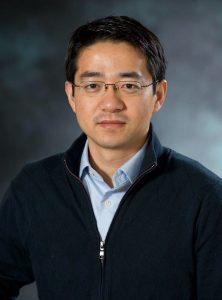A team of researchers led by Mo Li, associate professor in the Department of Electrical & Computer Engineering, has demonstrated, for the first time, using the hypersonic sound wave to bounce light
backward in an integrated photonic circuit. The new devices will lead to promising applications in microwave photonics, an emerging technology that combines fiber optics and wireless communications, as well as quantum information processing.
The team made the circuit with aluminum nitride, a type of piezoelectric materials—materials that change shape when an electrical voltage is applied. The group electrically excited sound wave with a frequency as high as 16 GHz such that the sound wavelength is only 500 nm, even less than the wavelength of light. On the chip they made in the Washington Nanofabrication Facility (WNF), they engineered a conduit—a waveguide—of only 0.8 micrometer wide for both light and sound. They showed that, in this waveguide where light and sound are confined in the same narrow space, the hypersound could bounce light very efficiently backward and at the same time shift the light frequency, a phenomenon called backward Brillouin scattering. The efficiency of the scattering process peaks at the so-called phase-matching conditions within a narrow range of combined optical and sound frequencies. Therefore, their device can be used as a tunable microwave filter, as well as an optical modulator that can convert a wireless signal to a light signal that can be transmitted on optical fibers.
Their research paper, titled “Electromechanical Brillouin scattering in integrated optomechanical waveguides,” was published earlier this month in “Optica”, the Optical Society of America (OSA)’s flagship high-impact journal. Besides Li, the authors include Qiyu Liu, a senior graduate student in ECE, and Huan Li, a senior postdoctoral associate. Both are members of the Laboratory of Photonic Devices.
The project was sponsored by the National Science Foundation.



